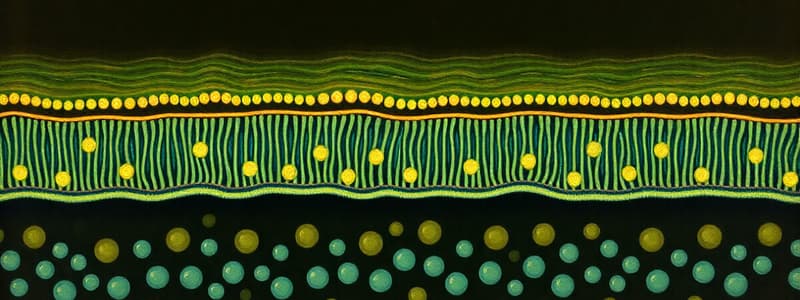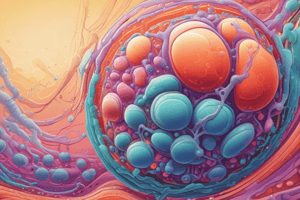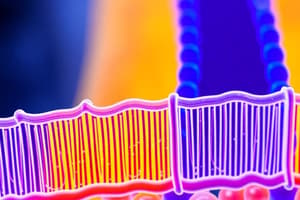Podcast
Questions and Answers
What is the primary function of the cell membrane?
What is the primary function of the cell membrane?
- To maintain the internal environment of the cell (correct)
- To provide structural support to the cell
- To store genetic information
- To allow all substances to freely enter and exit the cell
What is the approximate thickness of the cell membrane?
What is the approximate thickness of the cell membrane?
- 7.5 nm (correct)
- 10 nm
- 20 nm
- 5 nm
Which of the following makes up the majority of the cell membrane structure by weight?
Which of the following makes up the majority of the cell membrane structure by weight?
- Lipids
- Proteins (correct)
- Cholesterol
- Carbohydrates
What role do phospholipids play in the cell membrane?
What role do phospholipids play in the cell membrane?
How do intrinsic (integral) proteins differ from extrinsic (peripheral) proteins in the cell membrane?
How do intrinsic (integral) proteins differ from extrinsic (peripheral) proteins in the cell membrane?
What type of molecules do the heads of phospholipids face in the cell membrane?
What type of molecules do the heads of phospholipids face in the cell membrane?
What is one of the functions of cholesterol in the cell membrane?
What is one of the functions of cholesterol in the cell membrane?
Which substances are controlled in their distribution by the cell membrane?
Which substances are controlled in their distribution by the cell membrane?
What does osmolarity express?
What does osmolarity express?
In what scenario does a hypertonic solution occur?
In what scenario does a hypertonic solution occur?
What effect does a hypotonic solution have on a cell?
What effect does a hypotonic solution have on a cell?
Which of the following is true about isotonic solutions?
Which of the following is true about isotonic solutions?
What does hypo-osmotic indicate?
What does hypo-osmotic indicate?
How does osmolarity influence cell volume?
How does osmolarity influence cell volume?
Which statement is correct regarding tonicity?
Which statement is correct regarding tonicity?
What happens in an osmolarity of 290-300 mosm/L?
What happens in an osmolarity of 290-300 mosm/L?
What characterizes simple diffusion across a cell membrane?
What characterizes simple diffusion across a cell membrane?
Which statement about facilitated diffusion is true?
Which statement about facilitated diffusion is true?
What is a primary characteristic of osmosis?
What is a primary characteristic of osmosis?
What distinguishes facilitated diffusion from simple diffusion?
What distinguishes facilitated diffusion from simple diffusion?
Which of the following statements is true about simple diffusion?
Which of the following statements is true about simple diffusion?
In the process of facilitated diffusion, what happens to the carrier protein after binding a substance?
In the process of facilitated diffusion, what happens to the carrier protein after binding a substance?
What is the main difference between passive transport and active transport?
What is the main difference between passive transport and active transport?
Which feature is NOT associated with facilitated diffusion?
Which feature is NOT associated with facilitated diffusion?
What defines primary active transport in cellular physiology?
What defines primary active transport in cellular physiology?
What is the primary function of the sodium-potassium pump?
What is the primary function of the sodium-potassium pump?
Which of the following correctly describes the components of the sodium-potassium pump?
Which of the following correctly describes the components of the sodium-potassium pump?
What is required for secondary active transport?
What is required for secondary active transport?
Which of the following examples represents a primary active transport mechanism?
Which of the following examples represents a primary active transport mechanism?
What inhibits the function of the sodium-potassium pump?
What inhibits the function of the sodium-potassium pump?
What role do the beta subunits play in the sodium-potassium pump?
What role do the beta subunits play in the sodium-potassium pump?
How does the sodium-potassium pump maintain ion concentration gradients?
How does the sodium-potassium pump maintain ion concentration gradients?
Which transport mechanism requires energy to move substances across the cell membrane?
Which transport mechanism requires energy to move substances across the cell membrane?
Which type of diffusion does not require a carrier protein?
Which type of diffusion does not require a carrier protein?
What type of transport mechanism can become saturable?
What type of transport mechanism can become saturable?
Which mechanism involves the endocytosis of solid particles?
Which mechanism involves the endocytosis of solid particles?
What is a characteristic of active transport compared to simple diffusion?
What is a characteristic of active transport compared to simple diffusion?
What determines the specificity of facilitated diffusion?
What determines the specificity of facilitated diffusion?
Which statement correctly describes exocytosis?
Which statement correctly describes exocytosis?
Which process is involved in the uptake of substances in a solution?
Which process is involved in the uptake of substances in a solution?
What distinguishes simple diffusion from facilitated diffusion?
What distinguishes simple diffusion from facilitated diffusion?
Which characteristic of facilitated diffusion differentiates it from osmosis?
Which characteristic of facilitated diffusion differentiates it from osmosis?
In the context of membrane transport, when is a transport mechanism considered rate-limited?
In the context of membrane transport, when is a transport mechanism considered rate-limited?
Which statement correctly describes the movement of water compared to solutes in osmosis?
Which statement correctly describes the movement of water compared to solutes in osmosis?
What is a key factor that affects the ability of substances to undergo facilitated diffusion?
What is a key factor that affects the ability of substances to undergo facilitated diffusion?
Which condition is essential for simple diffusion to occur across the cell membrane?
Which condition is essential for simple diffusion to occur across the cell membrane?
Which molecule would likely require facilitated diffusion to pass through the cell membrane?
Which molecule would likely require facilitated diffusion to pass through the cell membrane?
Which characteristic is NOT associated with simple diffusion?
Which characteristic is NOT associated with simple diffusion?
What is the primary role of the phosphorylation step in the sodium-potassium pump?
What is the primary role of the phosphorylation step in the sodium-potassium pump?
Which of the following correctly describes the process of cotransport?
Which of the following correctly describes the process of cotransport?
What happens when K+ ions bind to the α subunit during the de-phosphorylation step?
What happens when K+ ions bind to the α subunit during the de-phosphorylation step?
In the sodium-potassium pump, how is low intracellular Na+ maintained?
In the sodium-potassium pump, how is low intracellular Na+ maintained?
What distinguishes counter-transport from cotransport in cellular mechanisms?
What distinguishes counter-transport from cotransport in cellular mechanisms?
Which statement accurately reflects the energy utilization of the sodium-potassium pump?
Which statement accurately reflects the energy utilization of the sodium-potassium pump?
What is a defining characteristic of the Na+-Ca2+ exchange mechanism?
What is a defining characteristic of the Na+-Ca2+ exchange mechanism?
During the sodium-potassium pump's operation, what is the significance of ATP hydrolysis specifically?
During the sodium-potassium pump's operation, what is the significance of ATP hydrolysis specifically?
What initiates the opening of ligand-gated ion channels?
What initiates the opening of ligand-gated ion channels?
Which statement accurately describes voltage-gated ion channels?
Which statement accurately describes voltage-gated ion channels?
What is the significance of ligand-gated channels at the neuromuscular junction?
What is the significance of ligand-gated channels at the neuromuscular junction?
Which factor is NOT directly proportional to the rate of diffusion across a membrane?
Which factor is NOT directly proportional to the rate of diffusion across a membrane?
In the diffusion equation, what does the variable 'D' represent?
In the diffusion equation, what does the variable 'D' represent?
What is a primary characteristic of nonselective channels?
What is a primary characteristic of nonselective channels?
What does osmolarity depend on in a solution?
What does osmolarity depend on in a solution?
Which of the following solutions would cause a cell to swell?
Which of the following solutions would cause a cell to swell?
What result occurs when a membrane's potential reaches a certain threshold level?
What result occurs when a membrane's potential reaches a certain threshold level?
Which of the following factors does NOT affect the net rate of diffusion of a substance?
Which of the following factors does NOT affect the net rate of diffusion of a substance?
What is the primary characteristic of a hypertonic solution?
What is the primary characteristic of a hypertonic solution?
How is tonicity defined?
How is tonicity defined?
At what osmolarity range is plasma typically situated?
At what osmolarity range is plasma typically situated?
In which scenario would a solution be classified as hyposmotic?
In which scenario would a solution be classified as hyposmotic?
Which characteristic is true of isotonic solutions?
Which characteristic is true of isotonic solutions?
What happens to cell volume when placed in a hyperosmotic solution?
What happens to cell volume when placed in a hyperosmotic solution?
What primarily allows water to diffuse through the lipid bilayer at a high rate?
What primarily allows water to diffuse through the lipid bilayer at a high rate?
Which statement accurately describes lipid-insoluble molecules in relation to cell membrane diffusion?
Which statement accurately describes lipid-insoluble molecules in relation to cell membrane diffusion?
What is a key characteristic of protein channels that ensures selective permeability?
What is a key characteristic of protein channels that ensures selective permeability?
Which factor determines the type of ion that a channel can transport?
Which factor determines the type of ion that a channel can transport?
How do sodium channels differ from potassium channels in terms of gating?
How do sodium channels differ from potassium channels in terms of gating?
What is a common characteristic shared by all protein channels?
What is a common characteristic shared by all protein channels?
Which of the following statements is true regarding diffusion through protein channels?
Which of the following statements is true regarding diffusion through protein channels?
What is the significance of the shape of a protein channel for ion transport?
What is the significance of the shape of a protein channel for ion transport?
Flashcards
Cell Membrane
Cell Membrane
A thin, elastic, and selectively permeable barrier that surrounds every cell, responsible for maintaining the cell's internal environment.
Phospholipid Bilayer
Phospholipid Bilayer
The phospholipid bilayer is the basic structural component of the cell membrane, formed by two layers of phospholipids.
Phospholipid Head
Phospholipid Head
The phosphate-containing head of a phospholipid is hydrophilic, meaning it attracts water and faces the extracellular fluid (ECF) and intracellular fluid (ICF).
Phospholipid Tail
Phospholipid Tail
Signup and view all the flashcards
Cholesterol
Cholesterol
Signup and view all the flashcards
Glycolipids
Glycolipids
Signup and view all the flashcards
Intrinsic (Integral) Proteins
Intrinsic (Integral) Proteins
Signup and view all the flashcards
Extrinsic (Peripheral) Proteins
Extrinsic (Peripheral) Proteins
Signup and view all the flashcards
Passive Transport
Passive Transport
Signup and view all the flashcards
Simple Diffusion
Simple Diffusion
Signup and view all the flashcards
Facilitated Diffusion
Facilitated Diffusion
Signup and view all the flashcards
Osmosis
Osmosis
Signup and view all the flashcards
Active Transport
Active Transport
Signup and view all the flashcards
Primary Active Transport
Primary Active Transport
Signup and view all the flashcards
Secondary Active Transport
Secondary Active Transport
Signup and view all the flashcards
Symport
Symport
Signup and view all the flashcards
Antiport
Antiport
Signup and view all the flashcards
Sodium-Potassium Pump (Na+-K+ ATPase)
Sodium-Potassium Pump (Na+-K+ ATPase)
Signup and view all the flashcards
Beta Subunit
Beta Subunit
Signup and view all the flashcards
Alpha Subunit
Alpha Subunit
Signup and view all the flashcards
Endocytosis
Endocytosis
Signup and view all the flashcards
Receptor-mediated Endocytosis
Receptor-mediated Endocytosis
Signup and view all the flashcards
Phagocytosis
Phagocytosis
Signup and view all the flashcards
Pinocytosis
Pinocytosis
Signup and view all the flashcards
Exocytosis
Exocytosis
Signup and view all the flashcards
Flux
Flux
Signup and view all the flashcards
Osmolarity
Osmolarity
Signup and view all the flashcards
Tonicity
Tonicity
Signup and view all the flashcards
Isotonic
Isotonic
Signup and view all the flashcards
Hypotonic
Hypotonic
Signup and view all the flashcards
Hypertonic
Hypertonic
Signup and view all the flashcards
Study Notes
Cell Membrane
- A thin, elastic, semi-permeable membrane that surrounds cells
- 7.5 nm thick
- Separates cytoplasm from the extracellular fluid (ECF)
- Maintains the cell's internal environment
- Transports molecules into and out of the cell
- Controls ion (Na+, K+, Ca2+, Cl-) distribution
- Contains protein receptors for hormones and neurotransmitters
- Generates transmembrane voltage differences (membrane potentials)
- Composed of proteins (55%), lipids (42%) & carbohydrates (3%)
Cell Membrane Components:
- Lipids: Form the basic structure of the membrane
- Phospholipids: Two layers (lipid bilayer)
- Head: Phosphate portion, hydrophilic (soluble in water), faces ECF & ICF
- Tail: Lipid portion, hydrophobic (insoluble in water), faces each other in the interior of the bilayer
- Cholesterol
- Glycolipids
- Phospholipids: Two layers (lipid bilayer)
- Proteins: Two types
- Intrinsic (Integral) proteins:
- Bind to the hydrophobic center of the lipid bilayer
- Transmembrane proteins: Span the entire bilayer
- Extrinsic (Peripheral) proteins:
- Bind to the hydrophilic polar heads of lipids
- Bind to intrinsic proteins
- Intrinsic (Integral) proteins:
Membrane Transport
- Passive Transport: Substances move across the membrane down their electrochemical gradient, no external energy required.
- Simple diffusion: Movement without carrier proteins
- Down a concentration gradient
- Not rate-limiting
- Not saturable
- No competition or stereospecificity
- Facilitated diffusion: With carrier proteins
- Down a concentration gradient
- Rate limited
- Saturable
- Shows competition and stereospecificity
- Osmosis: Passive flow of water across the semipermeable membrane
- Down a concentration gradient of water, from high to low concentration of water or low to high concentration of solute
- Simple diffusion: Movement without carrier proteins
- Active Transport: Movement of substances across the membrane against an electrochemical gradient, requires energy
- Primary active transport: Obtain energy directly from ATP hydrolysis
- Na+-K+ ATPase (Na+-K+ pump): Located in cell membranes, transports 3 Na+ from ICF to ECF and 2 K+ from ECF to ICF
- Ca2+-ATPase (CA2+-pump): Located in sarcoplasmic reticulum and cell membranes, maintains low intracellular Ca2+ concentration
- K+-H+-ATPase (proton pump): Located in stomach parietal cells, transports H+ ions from ICF to lumen
- Secondary active transport: Obtains energy indirectly from the movement of another molecule down its concentration gradient
- Symport: Both substances move in the same direction
- Antiport: Substances move in opposite directions
- Primary active transport: Obtain energy directly from ATP hydrolysis
Sodium Potassium Pump (Na+-K+ ATPase)
- Located in cell membranes
- Composed of four subunits: 2 alpha and 2 beta subunits
- Beta subunits: Anchoring subunits
- Alpha subunits: Binding sites for 3 Na+ on the intracellular side, binding sites for 2 K+ on the extracellular side, and binding sites for ATP on the intracellular side.
Types of Membrane Transport Compared
- Simple diffusion: Downhill electrochemical gradient, requires no energy, not rate-limited, not saturable, no competition or stereospecificity.
- Facilitated diffusion: Downhill electrochemical gradient, requires no energy, rate-limited, saturable, shows competition, and stereospecificity.
- Active transport: Uphill electrochemical gradient, requires energy, rate-limited, saturable, shows competition, and stereospecificity.
Endocytosis
- The extracellular material is trapped within vesicles that are formed by invagination of the cell membrane and detachment from the membrane.
- Types:
- Receptor-mediated endocytosis: e.g. iron & cholesterol
- Phagocytosis: The endocytosis of solid particles e.g. bacteria and dead tissue.
- Pinocytosis: The endocytosis of substances in solution e.g. proteins
Exocytosis
- The intracellular material is trapped within vesicles, which then fuse with the cell membrane and release the contents to the extracellular fluid.
- e.g. secretion of hormones, neurotransmitters, and waste products.
Sodium Potassium Pump
- The sodium-potassium pump is an active transport protein responsible for maintaining the concentration gradient of sodium and potassium ions across the cell membrane.
- The pump actively transports 3 sodium ions (Na+) from the intracellular fluid (ICF) to the extracellular fluid (ECF) and 2 potassium ions (K+) from the ECF to the ICF, using energy from the hydrolysis of ATP.
- Low intracellular Na+ and high intracellular K+ levels are crucial for maintaining cellular function.
- The pump utilizes about 40%-50% of the cell's energy.
Secondary Active Transport
- Utilizes the energy stored in the sodium concentration gradient generated by the sodium-potassium pump.
- Examples:
- Sodium-glucose co-transport
- Sodium-calcium exchange
- Sodium-glucose co-transport facilitates the movement of glucose from the lumen of the small intestine or renal proximal tubule into the cell, coupled with the movement of sodium down its concentration gradient.
- Sodium-calcium exchange pumps calcium out of the cell, coupled with the movement of sodium into the cell.
- Importantly, the movement of solutes can be in the same direction (co-transport or symport) or opposite directions (counter-transport or antiport).
Membrane Transport
- Cell membranes are selectively permeable, allowing some substances to pass through while restricting others.
Passive Transport
- Movement of substances across the membrane without requiring cellular energy.
Simple Diffusion
- Movement of substances down their electrochemical gradient without the assistance of any carrier protein.
- Characters:
- Down electrochemical gradient.
- Passive.
- No external energy required.
- No carrier.
- Not rate-limiting.
- Not saturable.
- No competition.
- No stereospecificity.
Facilitated Diffusion
- Movement of substances down their concentration gradient with the assistance of a carrier protein.
- Characters:
- With carrier proteins.
- Rate-limited.
- Saturable.
- Competition.
- Stereospificity.
Osmosis
- Passive flow of water across a semi-permeable membrane down a concentration gradient of water, from a high concentration to a low concentration.
Diffusion of Substances Across the Cell Membrane
- Different mechanisms mediate the movement of substances across the cell membrane.
Diffusion through Lipid Bilayer
- Lipid soluble substances can diffuse directly across the lipid bilayer.
- Example: O2, Nitrogen, CO2, alcohol.
- Water can diffuse rapidly through the lipid bilayer due to its small size and kinetic energy.
Diffusion through Watery Protein Channels
- Lipid-insoluble substances utilize protein channels to move across the membrane.
- Protein channels are selective for specific ions or molecules based on:
- Diameter
- Shape
- Electrical charges of the inside surfaces
Gating of Protein Channels
- Many protein channels are equipped with gates that control their permeability.
Ligand-gated or Chemical-gated Ion Channels
- Channels that open when a specific chemical agent binds to their associated membrane receptors.
- This binding triggers a conformational change in the channel, opening it.
Voltage-gated Ion Channels
- Channels that open when the membrane potential reaches a specific level.
- The change in membrane potential induces a conformational change in the channel, opening it.
Flux (Net Rate of Diffusion)
- The net rate of diffusion of a substance.
- Factors affecting flux:
- Concentration Gradient
- Diffusion Coefficient
- Membrane Surface Area
- Membrane Thickness
Osmolarity and Tonicity
- Osmolarity: Expression of the concentration of particles in a solution, measured in osmoL/L, independent of any membrane.
- Tonicity: Ability of particles to cause a change in cell volume, dependent on the osmolarity of the solution relative to plasma.
Solution Types:
- Isotonic: Same osmolarity as plasma.
- Hypotonic: Lower osmolarity than plasma.
- Hypertonic: Higher osmolarity than plasma.
- Hypo-osmotic: Lower osmolarity than plasma.
- Iso-osmotic: Same osmolarity as plasma.
- Hyper-osmotic: Higher osmolarity than plasma.
- When a cell is placed in:
- Isotonic solution: No change in cell volume.
- Hypotonic solution: Drawing water into the cell, causing cell swelling.
- Hypertonic solution: Drawing water out of the cell, causing cell shrinkage.
Studying That Suits You
Use AI to generate personalized quizzes and flashcards to suit your learning preferences.





